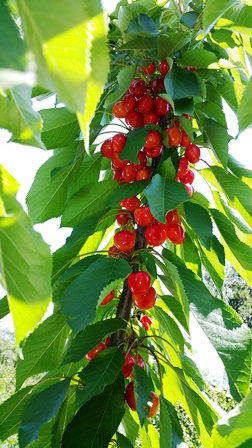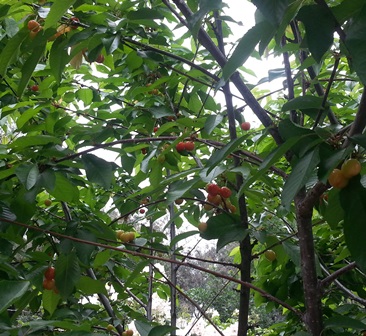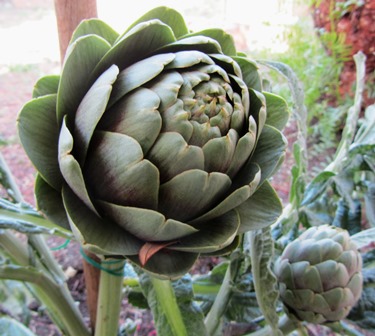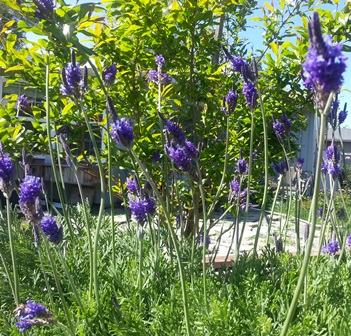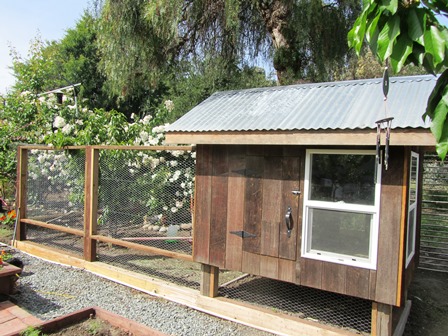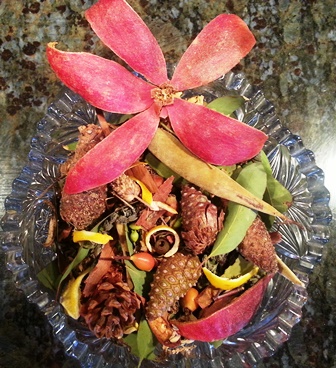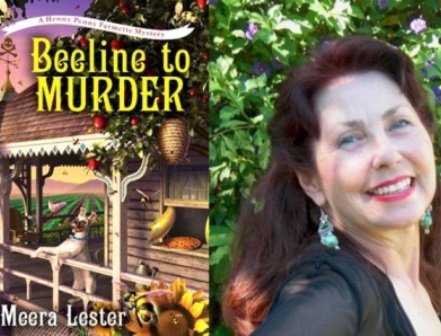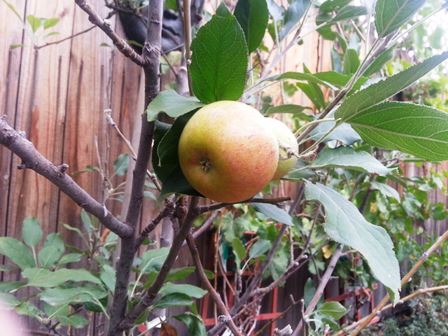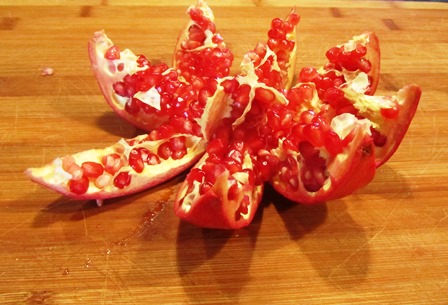Archive for the 'Plants and Trees' Category
Cherry Picking in the Backyard
The birds have discovered the red cherries on our backyard Bing and Stella trees. My hubby and I decided it’s high time we get busy with some major picking.
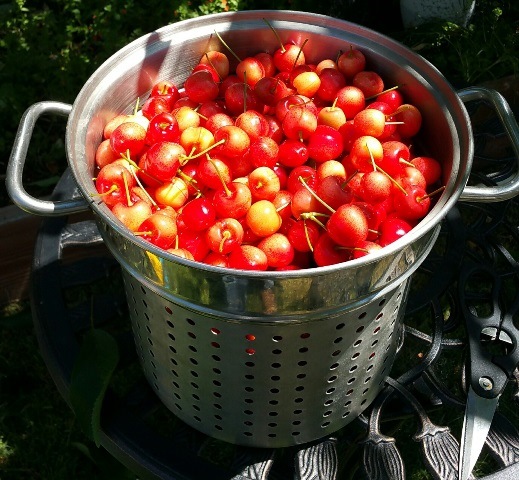
These succulent red cherries from the Stella and Bing trees look golden because of the sunlight on them
After breakfast, he climbed the ladder and I picked from the ground. I had to reach over my head into the trees for the choicest fruit. We’re removing a lot of the cherries, but not all because we like them to eat them fresh, right off the trees. But so do the birds.
The beginning of stone fruit season has started. Cherries are first up for my jam-making marathons. Next it’ll be the apricots, the plums, peaches, and nectarines.
Although I enjoy this time of year when I start making jam, by the time the cots and plums are ripe, I’m already wondering how I’m going to do everything on my to-do list for May and June including, harvesting honey. The bees won’t wait.
So . . . on it goes. But I wouldn’t trade my farmette life for anything. Some days, I feel like I’m living in the Garden of Eden.
* * *
If you enjoy reading about life on my Henny Penny Farmette, check out my cozy mysteries from Kensington, available from Amazon, Barnes & Noble, Walmart and other online stores as well as from traditional bookstores everywhere. My debut novel is A BEELINE TO MURDER and the second book in the series in THE MURDER OF A QUEEN BEE.
Sweet Cherries for Mom’s Day
When it comes to dark, sweet cherries, my favorite is the Black Tartarian. A mature tree can reach 30 feet in height and spread. It yields 3 to 4 bushels of fruit. The cherries have a sweet, full-body flavor. Best of all, the tree blooms early. We’re having some in a fruit bowl for our Mother’s Day brunch this year.
Black Tartarian trees need a pollinator with another sweet cherry. Options include Bing, Black Republican, Cavalier, Gold, Heidelfingen, Montmorency, Sam, Schmidt, Stella, Ranier, Van, Vega, Vista, and Windsor.
We’ve planted Stella and Bing as pollinators because these two cherry trees also have sweet, large size fruit and bloom about the same time as Black Tartarian. You can get by without a pollinator tree if you have one in the neighborhood. Trust the bees to pollinate your Black Tartarian when local cherry trees are in bloom.
Black Tartarian cherry trees prefer a sandy, well-drained soil, however, ours tolerate some clay conditions. We’ve improved the soil in the holes where we’ve planted the trees but the farmette soil overall is clay.
The Black Tartarian needs about 700 to 800 chilling hours, meaning hours of outside air temperatures between 32° and 45° Fahrenheit.
Birds love these cherries, too, so you are well advised to cover your Black Tartarian cherry tree with netting (available at gardening centers and DIY stores) unless you care to share.
* * *
If you enjoy reading about gardening, keeping bees, raising chickens, and creating delicious recipes, you might want to check out my novels from Kensington Publishing. The Henny Penny Farmette series of cozy mysteries are available online and in tradition bookstores everywhere, in hardcover, kindle, and mass market paperback formats.
See, http://tinyurl.com/gnnqr8z
The Murder of a Queen bee will be released September 29, 2016 in hardcover and kindle formats. See, http://tinyurl.com/j9vh7vr
Check out my article about “How to Make a Lavender-Sage Smudging Stick.” See, http://tinyurl.com/jds38e8
Growing Your Own Superfoods
Nutrient-rich fruits, vegetables, and berries are not difficult to grow. Some can even be grown in containers on a sunny patio. My favorite superfoods include blueberries, strawberries, raspberries, and blackberries as well as artichokes, assorted leafy greens, and figs. But in general, superfoods are those foods rich in nutrients, vitamins, fiber, antioxidants, and/or omega-3 and omega-6 fatty acids.
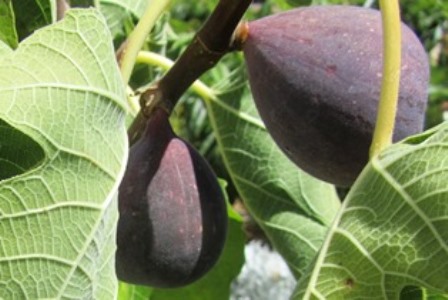
The dark purplish color is characteristic of the brown turkey fig, and this tree needs a lot of space in the garden
On the farmette, I’ve planted several fig trees that are semi-dwarf and include White Genoa, Brown Turkey, and Mission varieties. These trees produce two crops each year–one in spring and the other in the fall. The fruits can be dried or eaten fresh and contain omega-3 and omega-6 fatty acids and phenol for the prevention and treatment of coronary heart disease.
I’ve planted raised beds of strawberries, including Albion, a variety that produces berries from June to October, and Sequoia, a dependable berry that produces fruit from June to early frost.
In half barrels, I’ve amended soil and planted thornless raspberries and blackberries. I like growing them in containers with trellis support because otherwise they spread all over any area of the garden where they’re planted.
We planted one artichoke a couple of years ago. It dies back in late fall only to return in the spring as a new plant with shoots containing the small chokes. Artichokes are low in calories and aid in the lowering of cholesterol because of specific compounds found in the edible parts of the plant.
Early in the spring when I put in my sweet garden peas, I also plant leafy greens such as kale, collards, lettuces, and spinach. Some of these come back the next year after their growing season is over.
Blueberries are easy to grow when you remember to plant them in acid soil. These berries are considered a superior brain food. They are low in calories (84 calories per cup) and provide about 24 percent of the suggested daily amount of Vitamin C that the body needs.
Except for the fig trees and the artichokes that do better in areas of the garden where they have plenty of space to spread, the other nutrient-rich foods mentioned can all be planted and raised in containers. It’s so easy to grow most of these plants, why not give it a try.
Fern-leaf Lavender Is Easy to Grow and Re-seeds
My hubby brought home several Lavandula multifida plants in five-gallon pots. Also known as Egyptian lavender or Fern-leaf lavender, the plant’s foliage appears fernlike, hence its common name.
The Fern-leaf lavender carries its bluish-purple bloom on three- to five-inch spikes. It’s a pretty plant in the garden, however, its scent is not of lavender as one might expect but rather more like oregano. The foliage is more pungently scented than the buds.
This evergreen perennial is classified as a sub-shrub. In cold climates, the frost kills it. However, it can be grown as an annual. In California and Arizona, the plant blooms from spring through late summer into fall. The blooms are tri-pronged.
These plants reach a height of about 24 inches. They are among the 39 species of lavender that belong to the genus Lavandula in the family of Labiatae (a family which also includes mint, rosemary, thyme, sage, savory, and basil).
The Fern-leaf lavender (like other species of Lavandula) attracts bees, butterflies, and other pollinators. It’s a lovely plant that will provide spectacular color in any garden or around a pool.
For more gardening tips, delicious recipes, farm sayings, and a fun mystery, check out my Henny Penny Farmette series of cozy mysteries, including A BEELINE TO MURDER, and THE MURDER OF A QUEEN BEE.
My books are available on Amazon, Barnesandnoble.com, and other online and traditional bookstores. See, http://www.amazon.com/Beeline-Murder-Henny-Farmette-Mystery/dp/161773909X/ref=sr_1_3?s=books&ie=UTF8&qid=1458077651&sr=1-3&keywords=Meera+Lester
Tis the Season to Plant Bulbs for Spring/Summer Bloom
- These fragrant lilies return every year and bloom mid-summer
After the recent rainstorm, I walked around my farmette and noticed small slivers of green sprouting up. They seemed to be everywhere.
I could understand the grass coming back, but the sight of summer-blooming lilies shooting through the soil was quite surprising. The sight of them got me to thinking about planting some bulbs for a springtime bloom.

The bees are drawn to the sweet scent of narcissus that have naturalized in the yard and bloom in the spring
Over the weekend, I dug a bed for some tulips and planted nearly 100 bulbs–some early and others late-blooming.
I also will plant some sweetly fragrant grape hyacinth. The bees are attracted to the pollen because of the scent. Honeybees especially love foraging for pollen on violet-hued tulips.
Honeybees need to find pollen all through the year, so planting bulbs that bloom before the spring wildflowers makes sense for those of us who care about the bees.
For tips on farming, raising chickens, keeping honeybees, and creating farm crafts as well as having a good mystery to solve, check out my novel, A BEELINE TO MURDER. It’s available everywhere and also online at Amazon.com and barnesandnoble.com.

Blankets for Trees & Bees on Frosty Nights
I don’t like to take chances with my citrus trees when overnight temperatures drop to near freezing. I cover them with sheets and blankets.
My hives are in a wooden shelter with a tin roof and the back side open, so I can work without any encumbrance. But I don’t want the bees to have to work harder to keep the hive warm for the queen and babies, so I throw some blankets over my beehives, too.
Also, on particularly cold nights, I hang a warming lamp in my chicken house. My rule of thumb for my hens is when overnight temperatures are expected to drop below 45 degrees, I turn on the lamp so the hens aren’t stressed.
An advantage of hanging a heat lamp in the chicken house is to foster egg laying at time when shorter days of light slows egg production. The heat lamp makes light available to the chickens for a much longer period.
Easy Peasy Holiday Potpourri
Potpourri mixtures are easy to create and their long-lasting fragrance can add an attractive visual appeal and fresh scent to any room. You can find many items in nature. Use a festive basket or crystal bowl for displaying your potpourri.
Go on a nature walk to hunt for materials (see the List of Potpourri Items below).
Visit a shop for spices–whole nutmeg, cinnamon sticks, cloves, and allspice.
Cut or purchase herbs (preferably dried)–lavender, rosemary, and mint.
Combine nature’s materials with spices, dried herbs, and dried citrus slices and peels.
Add rose petals, lavender buds, and/or pinecones and red cedar bark.
Arrange pretty seashells or small pieces of driftwood.
Include fresh leaves and berries from eucalyptus trees and also he fuzzy seed pods of wisteria.
Put the potpourri in a pretty basket or cut crystal bowl; add a drop or two of essential oil if desired.
LIST OF POTPOURRI ITEMS
Combine using any of the following to create interesting mixes, textures, and colors.
- pinecones
- eucalyptus leaves and berries
- rose hips
- citrus peels
- pomegranate peel
- lavender buds
- rosemary
- yarrow
- seed pods
- red cedar bark
- cinnamon sticks
- dried rose petals
- citrus slices
- allspice
- peppercorns
- dried nutmeg
- dried apple slices
- carnation petals
- seashells
- dried rose petals
- dried mint
- essential oil—(rose, lemon, lavender, vanilla) to intensify scent
Find other ideas for farm crafts and delicious recipes in A BEELINE TO MURDER.
Click here: http://tinyurl.com/nhdae39
Celebrating the Season of Apples
It’s that time of year when the scents of cinnamon and apple potpourri mingle with hot mulled cider. Thank you, Johnny Appleseed.
Or should I say, thank you, John Chapman (1174-1845). Born in Leominster, Massachusetts, Chapman planted apple orchards on lands in the northeastern and mid-western parts of the United States, returning after several years to sell those orchards after they were producing.
He also gave away many trees and seeds. But he didn’t believe in grafting, and the trees he planted bore apples more suited to cider. See, http://www.smithsonianmag.com/arts-culture/real-johnny-appleseed-brought-applesand-booze-american-frontier-180953263/?no-ist
It was John Chapman’s father Nathaniel–a farmer–who encouraged his son to become an orchardist. John planted more than a few orchards around the Midwest on lands he bought, owned, and sold. His life gave rise to the folk tradition of Johnny Appleseed. Today, there are many festivals that honor his life and work as well as a U. S. postage stamp.
Today, you don’t need a lot of land to grow an apple tree or two. Even a small piece of land can accommodate the fruit tree, thanks to the availability of dwarf and semi-dwarf varietals. Apartment dwellers and people who have limited space can even espalier an apple tree against a wall.
On the Henny Penny Farmette, we are growing the thin-skinned Cox Orange Pippin dessert apple, among others. This late-season varietal was first grown in 1825 in Colnbrook in Buckinghamshire, England. The flesh is orangey-red and the flavor is sweet and nutty. These apples can be eaten fresh, used in recipes, or made into cider.
If you have some cider on hand and would like to create the mulled apple cider flavor, add a couple of cinnamon sticks, a teaspoon each of whole cloves and allspice with a half-gallon of cider and heat in a saucepan. Add a little orange juice or some slices of orange. After simmering for 8 to 10 minutes, strain the mulled cider into mugs. Consider making a batch of farmhouse doughnuts to accompany the cider.
FARMHOUSE DOUGHNUTS
Ingredients:
1 pkg. yeast
1 cup lukewarm milk
1/2 teaspoon salt
31/2 cups flour
1/4 cup canola oil, plus oil for frying
1 cup brown sugar
2 eggs, well beaten
3/4 teaspoon nutmeg
Directions:
Mix together the yeast and milk in a small bowl.
Combine flour with salt in a large bowl.
Add the yeast and milk to the flour and salt mixture and beat well.
Let the mixture rise for one-half hour.
Add all the other ingredients and beat well again.
Let rise for one hour.
Punch down the dough. If it appears too soft to roll out, add more flour.
Turn the dough out onto a well-floured board and let the dough rest for ten minutes.
Divide the dough in half. Roll one section of dough out to 1/2 inch thickness and cut with a doughnut cutter. Repeat the process for the other half of the dough.
Let the doughnuts rise for about an hour; fry in oil at 360 degrees Fahrenheit. When the doughnut has turned brown, flip over. Take care not to burn.
Remove from doughnuts from hot oil and drain on paper towels.
Place doughnuts in a bag with granulated sugar and shake to coat. Makes approximately two dozen doughnuts and holes.
De-Seeding a Pomegranate
Pomegranates are known since biblical times as a food of the gods. When ripe, the fruit’s leathery skin often splits open, exposing the red seeds inside. The fruit hangs like a jewel from a strong stem that must be cut or twisted to release the fruit.
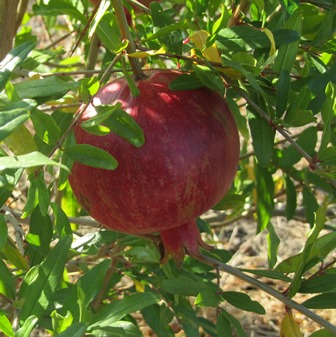
Ripe pomegranates have a leathery outer skin, membranes thicker than oranges, but sweet, juicy seeds inside
Inside a ripe pomegranate are hundreds of juicy, sweet seeds that resemble small pegs of sweet corn. Holding the seeds in place are membranes.
The ruby red juice will stain fabrics and your fingers, so you’ll want to be careful handling the fruit as you release the seeds. The juice will stain your cutting board, too, but that stain can be removed with a lemon juice or vinegar scrub.
Cut off the stem and the blossom end.
Make a long shallow cut from the top to the bottom and up the other side, but avoid cutting deeply to avoid damaging the seeds. Then rotate the fruit and make a second cut completely around. Make 6 or 8 such shallow cuts to create equal sections.
Pry open the fruit to expose the seeds (known as arils). Place the fruit into a basin of water for 5 minutes. Working over the basin, peel the skin off and strip away the membrane pieces to release all the seeds.
Pluck out the membranes and rinse the seeds in a strainer. They are ready to be tossed into salads, eaten fresh, or stored in an airtight container (not metal) for 3-4 days. The seeds may also be made into juice; however, straining the juice from the seed pulp will be necessary.
If you keep chickens, it might interest you to know they love fresh pomegranate seeds. Seeing a ripened fruit with its peel split open and seeds exposed is a temptation for them to peck at low-hanging fruit on the tree.
Growing and Sharing Farmette Figs
It’s that time of year when our fig trees reward us with a second crop of sweet, juicy fruit, best eaten right from the tree.
We aren’t the only ones who love to eat figs. The birds and raccoons are leaving telltale marks that they’re helping us devour this sweet fruit. And it’s no wonder.
Figs are a nutrient-rich food with antioxidant properties. They contain magnesium, vitamin B6, fiber, and beneficial amounts of calcium and iron.
We grow a couple of varieties of figs on the farmette–a White Genoa and Brown Turkey. Our neighbors also have towering fig tree with a canopy that reaches over the neighbor’s house. The tree is loaded now with baseball-size, dark purple fruit. I believe it’s a Black Mission fig, introduced into California by Father Junipero Serra who planted them in 1769 at the San Diego mission.
Our Brown Turkey fig produces a crop twice each year. The first crop, known as the breba grows on last season’s wood. The second, and more abundant crop, grows on new wood.The fig has rose-colored flesh inside a brownish-purple skin that tends to crack open with the fig is overripe.
The White Genoa is self-fruitful and has yellow-green skin with strawberry-colored pulp. The taste is mild and sweet and can be enjoyed as fresh fruit or paired with tangy goat cheese. The tree bears two crops each year and benefits from a vigorous pruning in the autumn after the figs are harvested.
Both figs will lose their leaves, leaving only their bark color and scaffolding as winter interest in the garden. The White Genoa’s bark is light gray whereas the Brown Turkey has a darker shade of grayish-brown bark.
These trees can be grown in containers and kept to about six feet tall for people who don’t have a lot of space for a tree that can otherwise reach 15 to 20 feet.
Figs aren’t fussy about soil, but won’t tolerate excessive water. They like the sun and are pretty hardy here in Northern California. Many figs are self-fruitful, but keeping bees means I have pollinators to help the fig crops along.
 Facebook
Facebook Goodreads
Goodreads LinkedIn
LinkedIn Meera Lester
Meera Lester Twitter
Twitter



